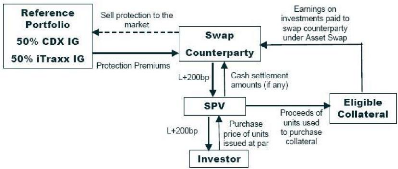1.2.4 Structured Non-Correlation Products
Unlike CSO tranches, the value of which relies heavily on
correlation assumptions linking default probabilities on single names, a range
of «correlation-free» structured credit products has emerged since
2004. Constant Proportion Portfolio Insurance (CPPI) and Constant Proportion
Debt Obligation (CPDO) products reference CDS portfolios, but their joint-loss
distribution is not tranched among investors.
Constant Proportion Debt Obligation: «the more you lose,
the more you bet»
First introduced by ABN-Amro in S2 2006, a Constant
Proportion Debt Obligation is a security whose principal and coupons are rated
AAA by rating agencies such as S&P and Moody's and that pays to the
noteholder quarterly EURIBOR/LIBOR coupons plus a spread around 100-200 bps
depending on issuing market conditions. Such a return is achieved by selling
credit protection on credit indices or on a portfolio of single-name CDS in an
amount that is adjusted dynamically throughout the transaction's lifetime: this
dynamic «leverage» function can reach as much as 15 times the initial
notional.

Figure 1.3: Structuring of a first-generation CPDO, referencing
credit indices
Let us define the following variables at time t in order to
summarize the few investment guidelines that rule the CPDO's behaviour:
· A = Notional of the security;
· NPV = Net Present Value of the security;
· MtM = Marked-to-Market value of all long positions on
credit indices and/or single-name CDS;
· Collat = Value of the assets collateralized in the
transaction to serve the EURIBOR/LIBOR component of the coupon;
· CA = Balance of the Cash Account of the structure; in
particular, can be affected by default losses;
· TRV = Target Redemption Value of the security;
· PVNotional = Present Value of the security's Notional as
discounted per the risk-free discount curve;
· PVCoupons = Present Value of the future coupons of the
security discounted as per the risk-free discount curve;
· PVFees = Present Value of the future running fees to be
paid by the noteholder and discounted as per the risk-free discount curve;
· TNE = Target Notional Exposure in credit indices or
single-name CDS;
· F = Shortfall Multiplier, assumed to be constant in this
example;
· lb = Lower Bound cash-out threshold, expressed as a
percentage of the security's notional;
· TL = Target Leverage function.
The aim of the structure is to increase the security's NPV in
order to hit the TRV (a «lock-in» event: in this case, the credit
portfolio is unwound and the proceeds of the transaction are high enough to
cover all future promised coupon, fee and principal payments until maturity by
construction of the TRV aggregate. At the same time, the structure must avoid
any «lock-out» event, which takes place when the security's NPV hits
a fixed percentage lb, usually around 10%, of the security's notional N.
As long as no lock-in nor lock-out event has occured, the
leveraging mechanism described hereafter expresses the Target Leverage function
TL(t) as a linearly increasing function of the structure's shortfall, defined
as the difference between the TRV and the NPV:
NPV (t) = MtM(t) + Collat(t) + CA(t)
TRV (t) = PV Notional(t) + PV Coupons(t) + PV Fees(t) TNE(t) = F
· (TRV (t) - NPV (t))
T NE(t)
T L(t) = A
|
(1.2)
|
|
In other words, the CPDO's leveraging mechanism enables the
structure to increase its credit exposure when the shortfall increases, i.e.
when the security's NPV incurs MtM or default losses: «the more you lose,
the more you bet». Conversely, MtM gains translate into a reduction in the
structure's credit exposure.
Constant Proportion Portfolio Insurance: placing greedy but
secured bets
Originally designed for equity underlyings, Constant
Proportion Portfolio Insurance (CPPI) products referencing credit-linked assets
have developped in the past three years. Unlike CPDOs, CPPIs are
principal-protected at maturity. In other words, the investor will always
receive the notional of the security at its maturity, whereas the CPDO
noteholder can end up with as little as lb% of his initial investment.
The CPPI is a security whose principal is protected at
maturity and whose coupons
can be rated by S&P and/or Moody's and/or
Fitch. Similarly to CPDOs, the rated
CPPI pays to the noteholder quarterly EURIBOR/LIBOR coupons
plus a spread around 50-100 bps depending on issuing market conditions. This
return is achieved by selling protection on a portfolio of single-name CDS in
an amount that is adjusted dynamically during the transaction's lifetime. This
dynamic «leverage» function can reach as much as 10-12 times the
initial notional.
Notations introduced earlier to describe the CPDO structure
remain valid hereafter. In addition, we define the following variables at time
t:
· BF = Bond Floor: value of a risk-free zero-coupon bond
maturing at the legal maturity of the security;
· R = Reserve;
· RM = Reserve Multiplier.
A CPPI lock-out event happens whenever the security's NPV hits
the Bond Floor BF. A lock-in event is the same as for CPDOs. The leveraging
mechanism is different however: the CPPI's target leverage function TL is an
increasing function of the Reserve R, defined as the difference between the
security's NPV and BF.
|
R(t) = NPV (t) - BF(t) TNE(t) = RM · R(t)
TNE(t)
TL(t) = A
|
(1.3)
|
The CPPI's leveraging mechanism enables the structure to
increase its credit exposure when the reserve increases, i.e. when either the
security's NPV increases due to MtM gains or its BF rises as a result of lower
interest rates. The more money you make, the more you can afford losing by
increasing your bets.
| 


